
It is over 18 years since three plywood-hulled RC one metre model schooners designed and built by an Australian-born turned patriotic Kiwi known as the `Plywood King’, John Alfred Spencer were jointly launched on the sea waters of a bay on the other side of Okiato in Northland, New Zealand. The photograph taken by the writer shows, Fijipsy Jack, Fiji Magic and the prototype Fiji Fun coming into the shallows in close formation on 8th January 1993 after a maiden sail.
Spencer had closed his yacht building operation in Browns Bay on Auckland’s North Shore in the North Island, and had retired after many years of designing and building a host of successful keel boats. They had included, the Sydney to Hobart line honours winner Buccaneer and Infidel which after having been sold to an American became Ragtime and had gone on to a successful racing career in ocean racing and a legend in the Transpac races to Hawaii.
Spencer had also designed and built the Javelin boats and other Spencer cruising yachts of varying sizes and had been aboard Buccaneer (and it is said had been `inside the bow of her hull’, fingers crossed while watching the plywood timber taking a pounding as the boat raced up the Derwent on a reach into Hobart in Tasmania).
Upon retirement where he ran away from everybody and built a house up on the hill at Okiato, the late Fred Martin got John interested in model yachts, and the writer having in his employment with the Fiji Islands National Tourist Office agreed to sponsor the first ever National Regatta for the One Metre yachts, established contact with him by mail.
A close liason developed leading up to the yacht designer being convinced by me that he should develop and build in his workshop at his house, a one metre in length model schooner that I (and others) would be interested in for non-competitive fun sailing which later became known as `windling!’

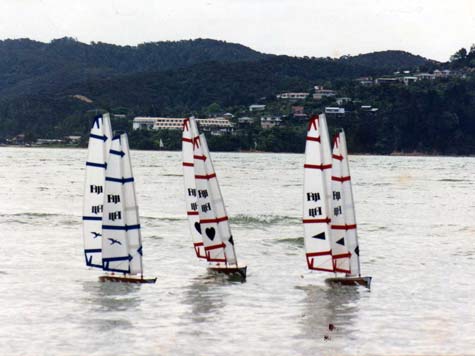 Together they sailed after launching. Together they sailed after launching.
|
Sailing at Onepoto
left - `Goose winging’ on launch day |
Showing off her livery |
Designer/Builder John Spencer with first two schooners
|
After much correspondence between us (John in large longhand – he never used a computer, even submitted all his monthly columns to Boating New Zealand that way)), and about three months, John had built not one but three schooners, two using his double chine Why Not one metre hull design, the third using his Merry Hell hull.
Things as I remember, moved pretty quickly from there on and Spencer had no plans but within weeks had produced a five sheet rough but accurate set that showed everything,
hulls and deck, rudder, keel, and most important, the unique cat-rigged and unstayed mats drawings for the medium rig. I went out and spent my own money and had fifty sets photocopied for in the region of four hundred and seventy New Zealand dollars which were then given away to people who were genuinely interested in building them.
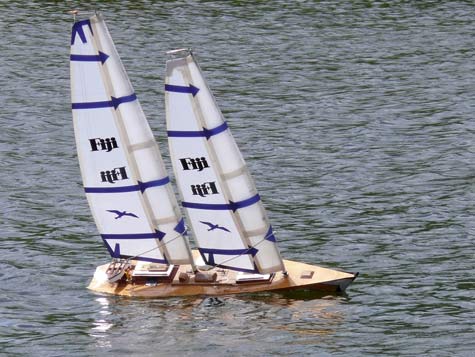
Fijipsy Jack in Auckland – photo by Richard Plinston
John and I found that Chris Jackson, then editor of Marine Modelling International in the UK who was a friend of mine asked if he could add the boat to the Traplet Plans Service, and he made an arrangement with an engineer mate called Henry Farley to produce a professionally done set of plans. The writer was going on leave to Britain, met Farley and viewed the fire-red in colour FM schooner he had built at his home.
Marine Modelling International launched the plan over three consecutive issues (May, June and July 1994) and in 2008 Fijipsy Jack was featured on the cover and over two pages within the November issue. All the photos were in colour and the cover was a wonderful shot by New Zealander, Richard Plinston.
That I am aware of, FM schooners were built in several parts of New Zealand, one that I am aware of in Falmouth Cornwall, England (by my friend, Ken Impey), one in Victoria, Australia by Barry Gibson, one in Japan another in Malaysia. There may well be a few in Britain but I am not party to that information, but I have a belief that sales of the FM schooner plan by Traplet never achieved great popularity.
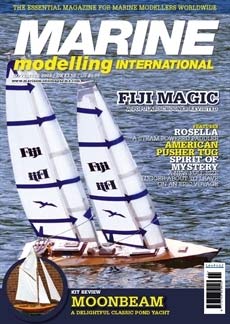
When she became a Cover Girl
Deck detail added
right: The UK `plan boat’ even sailed uphill! |
|
|
Barry Gibson of Australia was one of the first to order plans – he built FM schooner Eric
left: Jim Watson of Wellington, NZ with his Fijimminy Cricket |
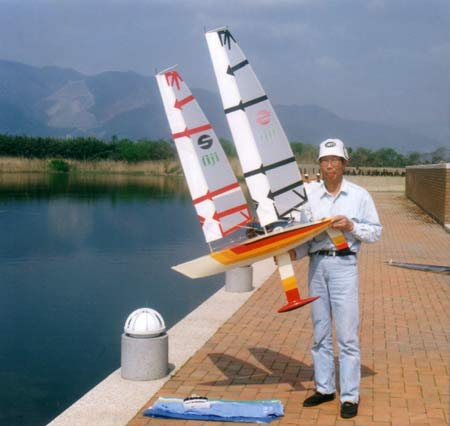
The first one in Japan, Shiomi San with his colourful Fiji Flying Fish
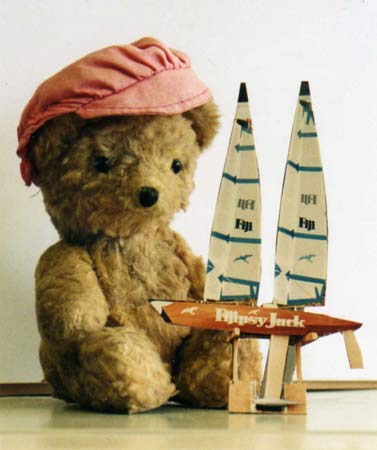
Bear with me, I just gotta show you mine!
One reason I believe is the lack of both Spencer and Farley plans to present the boat in scale fun sailing guise, in other words to show the model with a modicum even of deck detail as a cruising schooner. I tried to suggest that a simple layout of a deckhouse, stowed dinghy and a hatch (all easily built and installed by most shipmodellers) would have added to the appeal, since the schooner was not a racing boat and therefore the flat ironing board deck was too bare and lacked `interest’ and appeal. There is an old saying ` `neither fish nor fowl’ and a couple of years after I got my prototype FM schooner I `customised’ Fijipsy Jack to become what I saw as being an interesting boat attracting attention whenever she is sailed with our Ancient Mariners.
There appears to be renewed interest, this time in America and I am looking forward to when I receive photos of a new one to be built by John Davis, Editor of the AMYA magazine, Model Yachting.
Schooners are on the crest of a wave of renewed interest, and the enthusiasm will drift down to model yachts as schooners. With the FM plan still available, don’t wait until it is withdrawn and all you are able to then say is “I remember when plans of that schooner were available!” (How does that saying go. Should have, Could have, Would have or something like that?)

Stardate April 14th 2011 - Onepoto pond, Northcote, Auckland, New Zealand, I enjoyed what was perhaps the most beautiful ninety minutes of sailing ever with Fijipsy Jack, up and down the length of the pond as she barreled along on the flat water in medium breezes, her sails catching the wind and taking her along quickly and gracefully. I am penning these one hundred (and a bit) words on this same day, and if I never had another opportunity to sail her again, this is the hour and a half sail that I would choose to remember above all others while `remembering’ was possible.

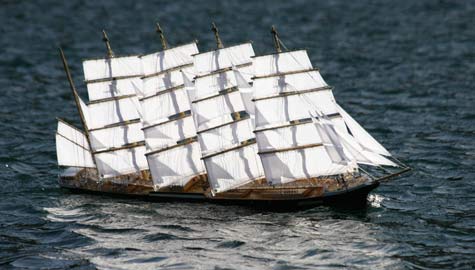
Helter skelter, hurry scurry – the Lauren & Rachel
Neville Wade specialized in the building and sailing of really beautiful square-rigged sailing ship models. His latest, the Lauren & Rachel is a five masted barque based on the Potasi of the Flying P line, a German sailing ship line involved in transport. The real boat’s route of operation was between Germany and Chile and she was built to withstand the seas and winds of Cape Horn. Potosi’s first four masts were square-rigged, the fifth with fore and aft sails.
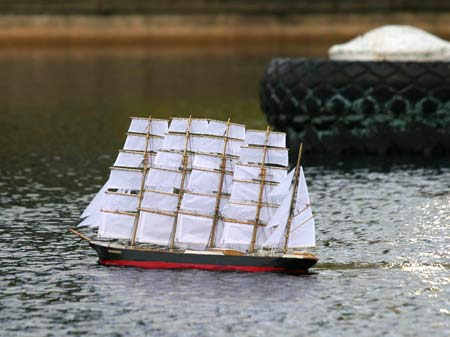
Heading for Cape Horn perhaps?
Lauren & Rachel gathers momentum. |
|
Built in 1/116 scale the length of the model (bowsprit end to the stern rail) is 1,070mm, her bean 120mm and the model carries a removable keel weight of 2.07 kg. She will sail happily in winds up to 15mph.
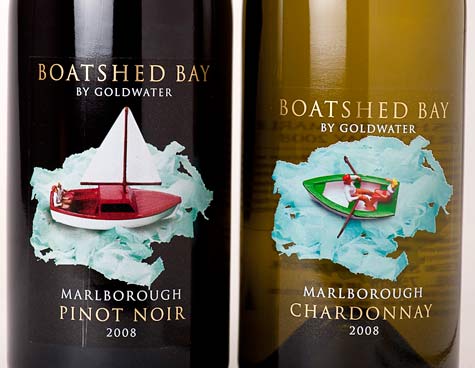
From schooners and German master-modeller’s ship building to the rather `specialist’ subject of wine. I am not into pretending that I know a damn thing about wine, other than I either like a wine or I don’t. The world of pretense gobble-de-gook where one waxes lyrical about wines being `perky little numbers with charming hints of seduction freely dispensed with every sip’ (and all that stuff) is not for me and I leave that world to those engaged in fancy wine talk for the purpose of impressing others.
No, this item is about wine labels, two in particular from Goldsmith in New Zealand. These are indeed lovely labels, and having tried the Pinot Noir at a family function, I can only say that this was a wine that was as `refreshing as a spray on the lips of waves off the incoming tide’ (post desalinisation of course!) I should just say that I liked it (which I did), the label having `deliciously tickled my design buds prior to the actual sampling. My photographer son took the excellent photographs.

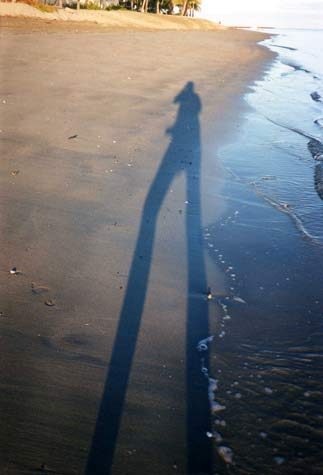
I am actually so inspired that I have decided to go into wine-making myself. My introductory wine is going to be a red made from supermarket-purchased grapes from which I have deftly removed the pips - (I won’t go into the methodology of that
process!) to be marketed as Tall Beachcomber. I am so thrifty I have refused approaches from advertising and design companies, even taken the photograph of my own shadow on a Fiji beach for the label. My darling wife doesn’t yet know that the family room is to be taken over for the winery! (Well it is adjoining the kitchen and I need the use of the sink!) She will warm to the idea in time.

No thank you, I don’t fancy a swim with a mermaid and I don’t want to be a `mermale’ or a `merman’ either. Somebody starts a crazy fad in fun and the next thing that happens is that the internet goes totally bananas with dozens if not hundreds of sites all set to take advantage and absolutely cream customers with ridiculously priced products that (the sites say) will transform them into what they are not or can ever be via the medium of fancy dress.If being an underwater reptile more appeals to you, they can deck you out instead so that you can become a cross between a crocadorious and a pincer-snapping crabavarian and if you can hold your breath for a long time underwater, who knows, a mermaid may appear and you can pinch her on her cheeks as she swimmeth by. Nobody will even know (unless she doth protest!)

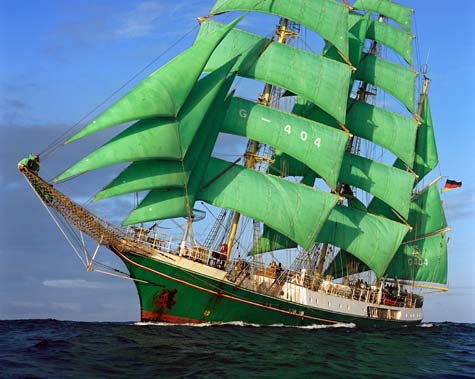
Alexander von Humboldt
The Alexander von Humboldt is a German ship built in 1906 as Reserve Sonderburg. Retired in 1986 and after conversion to a barque in 1988 she went into second service as a sail-training vessel familiarly known as the `Alex’ Alexander von Humboldt was a German naturalist and explorer born 1769 in Berlin.
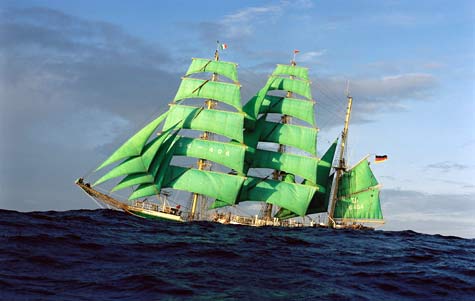
Hull hidden in a trough, the `Alex’’ at sea
Operated by a German sail-training organization DSST, she carries 25 crew and 35 trainees. She has a sail area of 1,35.6m and her sails are all green in colour.
The ship’s owners have built a new sail-training ship, Alexander von Humboldt II which will be the first new sail-training vessel in Germany since 1958, and the new ship is to be delivered at the end of September this year.
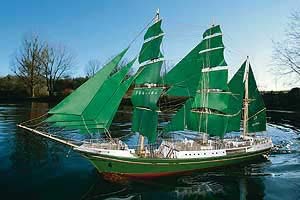
The best I could find, the best they could do
A grouse about Graupner the German model kitset and ready to sail manufacturers while on this subject. The company introduced way back in 2007 I am told, quite a decent looking ARTR (which stands for Almost ready to run) 1,350mm long model of the current Alexander von Humboldt. Would you believe it if I told you that try as I did to contact Graupner in Germany I was never successful, and the only image I could obtain of one of the models on the water was the rather cruddy, half-blurred and far too small photograph shown above which does the model no justice whatsoever! On the flip side, Mr Albert Bote of the company operating the vessels could not have been more helpful with granting authority to use the other photos of the real ship shown above.

-30- | 
